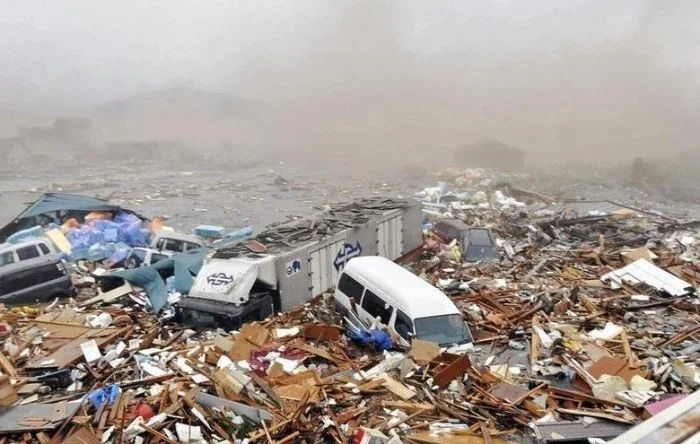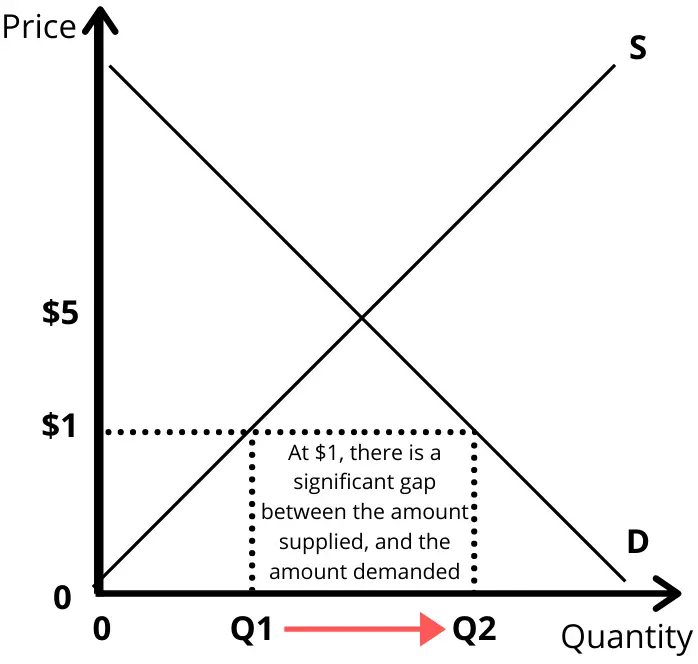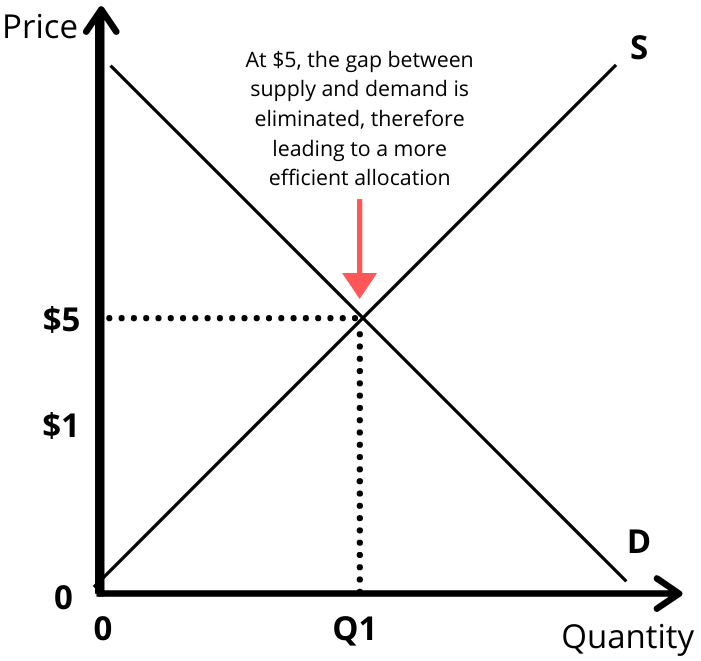Price Gouging: Definition & Examples

What is Price Gouging
Price gouging is where the seller increases the prices of their goods or services to a level considered unreasonable and unfair. It arises due to a sharp surge in demand and/or a shortage of supply – normally as a result of natural disaster such as a hurricane or earthquake.
Price gouging is seen as unethical and morally wrong as sellers take advantage of buyers by significantly raising prices. For example, during the 2020 Coronavirus outbreak, there was a sharp increase in demand for hand sanitisers, which help prevent the contraction and spread on the disease. Stocks were depleted as people panic bought supplies. As a result, price gouging occurred with hand sanitisers selling at over $50 per eight-ounce bottle in some cases.
However, price gouging can also occur during periods of supply shortage. For example, as a result of Coronavirus, many supply chains were disrupted – leading to a shortage in supply of semi-conductors. As a result, many products ranging from laptops to cars to video games consoles became in short supply. In turn, we saw a number of third parties engaging in price gouging by taking what supply there was, and selling it at a premium. For example, the PlayStation 5 was selling at around $490 in retail stores. However, due to the supply shortage, price gougers were able to sell to consumers at a hefty uplift of $1,000 and sometimes more.
Key Points
- Price gouging is where products are sold in excess of its usual market price – usually as a result of a shock in supply, demand, or both.
- The main causes of price gouging evolve around supply shocks such as hurricanes and tsunamis which destroy the local infrastructure.
- Price gouging is bad in the sense that it is seen as morally wrong, yet it is often necessary in order to create the incentives to increase supply or reduce demand.
Causes of Price Gouging
1. Concentrated Markets
Although price gouging usually takes place due to a natural disaster, there are cases whereby big businesses collude to increase prices. For instance, in 2019, pharmaceutical manufacturer, Aspen, was found guilty of paying two other firms to leave the UK market for fludrocortisone acetate.
In turn, the firm increased the price of fludrocortisone acetate by over 1800 percent, and was subsequently fined by the UK government. Yet these cases are relatively few and far between, at least for big businesses. This is because big firms have a reputation to maintain, so largely avoid such activities. The value of a large firm such as Apple or Samsung lies largely within its brand image – so anything that tarnishes that can have an impact on sales. However, whilst it is price gouging is rare among big firms, markets with a high concentration are more prone to price gouging because it’s easier to collude.
For example, in the UK cigarette market, leading brands, Imperial Tobacco and Gallaher, were found guilty of colluding and price gouging in 2010. The companies produce 9 out of 10 cigarettes in the UK market, with the UK government subsequently fining them £225 million.

As such, when markets have fewer competitors, it makes it easier to fix prices and collude between firms. As the market concentration is greater, they can force prices up in the knowledge that consumers will have to buy at a higher price due to lack of competition. Therefore, under such circumstances, price gouging is more likely to occur.
2. Supply Shock
Supply shocks specifically affect supply rather than supply AND demand. For instance, hurricanes can increase demand and decrease supply at the same time, but would not classify as a supply shock if it had little impact on the wider economy.
Therefore, a supply shock is where there is a specific disaster or consequence that affects a specific area, but which ripples throughout the economy. For instance, a natural disaster in China may cause significant supply delays to some Western manufacturers that rely on it for its parts. One such example can be seen from the 2020 COVID outbreak which affecting supply chains not only in China, but across the world – leading to shortages of electronic components to groceries.
Supply shocks are not always seen in the same light as shocks in demand, at least not on an international level. This is because, from the consumer’s point of view, nothing has changed. They still want the same amount of goods, but there is less available. Whether it’s driven by supply or demand, consumers will still see fewer goods on the shelf.
There is also less of an emotional effect. For instance, the 2011 Japanese Tsunami caused significant damage to the supply chain of car manufacturers. It destroyed factories and the Fukushima nuclear plant, which supplied energy across Japan. As a result, the supply chain was significantly impacted and prices rose by up to 6 percent.

The Devastation left behind from the 2011 tsunami in Japan. Source : REUTERS/YOMIURI
There wasn’t a massive outcry of manufacturer’s price gouging even though prices rose. At least not in the international community such as in the US and the UK. It made sense because there was no emotional attachment. Consumers from those countries weren’t directly affected by the tragedy, so the price gouging didn’t seem like manufacturers were directly taking advantage of the situation.
However, for those affected by the tsunami in Japan, it was far more emotionally charged. People need food, water, and other goods, yet suppliers increased prices as a result of the disruption to supply. At the same time, demand increased rapidly due to panic.
What we see as a result on a local scale is a shortage of supply, but also an increase in demand. There is a level of panic that is associated with natural disasters, which creates an equally disgusted reaction to price gouging. However, this is not seen so much on an international scale, at least when there is a shortage of supply.
3. Over-Demand
During a natural disaster or other such event, panic can often ensue. For example, many consumers started panic buying during the 2020 Coronavirus outbreak. Shops were left without hand sanitizer, toilet rolls, and many other products. Demand surged, and companies were unable to keep up.
Whilst price gouging is technically illegal in many countries, it didn’t stop small businesses and individuals from re-selling at extraordinary mark ups. The reason for such follows law of supply and demand.

Picture of price gouging during the 2020 Coronavirus outbreak. Source: https://knowyourmeme.com/photos/1779271-mildly-infuriating
As demand increases, prices increase until it encourages enough supply to bring it back in line with the new level of demand. So when there is a sharp increase in demand, it is extremely difficult for suppliers to extend the capacity to meet demand in the short-term. In turn, this creates rationing, panic, but also price gouging.
As a result, we see supply shortages at big supermarkets such as Walmart and Walgreens, among others. During the coronavirus outbreak in 2020, consumers were stocking up on toilet paper, which meant there was none left for others. Had the prices been higher, it would have prevented such a misallocation, meaning people would buy fewer, thereby limiting the amount of panic buying and allowing more people access to such products. Higher prices would have deterred consumers from piling up on toilet paper that they don’t actually need.
Is Price Gouging Good or Bad?
From an ethical point of view, price gouging is bad. It charges consumers a higher price when they are in dire need of resources. For instance, prices of bottled water usually increase after hurricanes hit. Those affected are left without their home and possessions and are being forced to pay 3 times the normal price.
Someone who is now homeless due to a natural disaster is now being forced to pay $25 for a bottle of water. Most of us would agree that this is morally apprehensible. Yet at the same time, it creates the most optimal allocation of resources.
For example, let’s say there are 200 bottles of water and 100 customers. That allows each customer to have 2 bottles. However, when faced with a crisis, customers often panic buy. The first 10 customers buy 20 bottles each, thereby leaving none left for the other 90.
Now, at $1 a bottle, those 10 customers are not dissuaded from stocking up on 20 bottles. Yet, should the sellers increase the price to $5 a bottle and engage in price gouging, those 10 customers wouldn’t buy so many. This leaves the other 90 a far greater amount than they would have otherwise.
At the same time, it also gives an incentive for the producer to stock more products. As the profit margins will be much higher, the incentive is much greater.
When prices are not allowed to rise to respond to increased demand, we see a huge gap between demand and supply. The graph below illustrates this issue. At $1, the supply is significantly below the level of demand, meaning the is a shortage for those who need supplies.

However, once prices are allowed to adjust to demand, supply increases and demand falls. Therefore, the allocation of resources becomes more efficient. Those who are stockpiling and taking resources from others will be dis-incentivized to do so from higher prices.

Is Price Gouging Illegal
In the US, price gouging laws are devolved to the states. The majority of which have some form of laws making it illegal. Although these are only effective during a declared ‘state of emergency’. Nevertheless, there are 15 states without such restrictions. They include Alaska, Arizona, Colorado, Delaware, Maryland, Minnesota, Montana, Nebraska, Nevada, New Hampshire, New Mexico, North Dakota, South Dakota, Ohio, and Washington.
The other 35 US states have strict regulations, with fines of up to $25,000 per violation. On top of that, some states also make price gouging illegal whether or not there is a ‘state of emergency’. For instance, Michigan makes it illegal as long as the consumer has been charged a price that is way in excess of the ordinary market value.
Elsewhere, the EU covers price gouging within its competition and antitrust rules. Whilst price gouging is illegal in the EU, it is relatively rare as there are fewer natural disasters that would result in such. Nevertheless, cases have occurred in industries whereby it is difficult to identify whether price gouging has occurred. For example, in the pharmaceutical market, the EU investigated Aspen for over-pricing its cancer medications.
Price Gouging Examples
Price gouging is not as common as it used to be – with big brands facing a big public backlash if they act in such a way. However, price gouging is usually more prevalent in smaller companies that are not so dependant on their brand image. Some recent examples of such price gouging include hand sanitizers during the COVID-19 crisis, gas and water in the aftermath of Hurricane Harvey, and the Fludrocortisone Acetate drug in 2019.
- Coronavirus 2020 – Hand Sanitiser
- Hurricane Harvey 2017 – Gas and Water
- Aspen – 2019 Fludrocortisone Acetate

Coronavirus 2020 – Hand Sanitiser
During the 2020 outbreak of Coronavirus, the public was told to wash their hands and keep them clean to avoid germs. As a result, the stock of hand sanitisers fell rapidly as the population panic bought in fear of catching the virus.

Subsequently, many nations such as the US and much of Western Europe saw shortages and sky-rocketing prices for hand sanitiser. The problem was that much of the price gouging that occurred was through small and independent providers.
So even though the practise is illegal, it was practically impossible to catch the culprits.
Hurricane Harvey 2017 – Gas and Water
Hurricane Harvey hit the state of Texas in 2017 and left devastating damage. People were left without electricity, their possessions, and particularly, their home. There was inevitably a surge in demand for goods such as gas and water, which many firms responded to with higher prices.

We would identify this as price gouging as prices for items like a bottle of water increased to $8.50 according to reports. Furthermore, a gallon of gas was said to have cost $20 per gallon in some places.
By most peoples standards, that is an unreasonably high price and would constitute price gouging.
Aspen – 2019 Fludrocortisone Acetate
In 2019, pharmaceutical manufacturer, Aspen, was found guilt of price gouging fludrocortisone acetate tablets in the UK. It paid two other companies to stay out of the market so that it could inflate the price of the drug by 1800 percent.
The company was found guilty, fined £2.1m, and committed to allow at least two competitors into the market. This was the second case against Aspen since 2017, where the EU also investigated it for price gouging cancer related drugs.
FAQs
The law depends on which country or region you’re from. For instance, it is illegal in all but 15 states in the US. It is also illegal in the EU under competition rules, but many small companies slip through the net.
Price gouging is illegal in many countries because it is seen as unethical and morally apprehensible; particularly during periods of emergency, such as earthquakes and other natural disasters. Some companies price gouge during this period, which is widely considered unreasonable whilst people are suffering.
Price gouging is good in an economic sense. In the main, it allocates resources most effectively by forcing demand down in line with supply. However, there are some cases whereby collusion and anti-competitive policies are used to price gouge, which is wrong both on a moral and economic level.
About Paul
Paul Boyce is an economics editor with over 10 years experience in the industry. Currently working as a consultant within the financial services sector, Paul is the CEO and chief editor of BoyceWire. He has written publications for FEE, the Mises Institute, and many others.

Further Reading
 Bait and Switch - Bait and switch is a deceptive sales tactic that involves advertising a desirable product or offer to attract customers, only…
Bait and Switch - Bait and switch is a deceptive sales tactic that involves advertising a desirable product or offer to attract customers, only…  Corporate Governance: Definition, Pillars & Format - Corporate governance is the set of rules and relationships which seek to align the interest of the board of directors,…
Corporate Governance: Definition, Pillars & Format - Corporate governance is the set of rules and relationships which seek to align the interest of the board of directors,…  Arithmetic Mean - The arithmetic mean, also known as the average, is the sum of a set of numbers divided by the total…
Arithmetic Mean - The arithmetic mean, also known as the average, is the sum of a set of numbers divided by the total… 